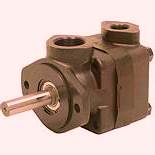A rotary vane pump is a positive displacement pump that consists of vanes mounted to a rotor that rotates inside a cavity. In some cases these vanes can have variable length and/or be tensioned to keep contact with the walls as the pump rotates. It was invented by Charles C. Barnes of Sackville, New Brunswick who patented it on June 16, 1874. here have been various improvements, including a variable vane pump for gases (1909). These are considered less significant than other vacuum pumps for high-viscosity and high-pressure fluids, and are complex to operate. They can endure short periods of dry operation, and are considered good for low-viscosity fluids.
The basic of vane pumps have a circular rotor rotating inside a larger circular cavity. The centers of these two circles are offset, causing eccentricity. Vanes are able to slide into and out of the rotor and seal on all edges, creating vane chambers that do the pumping work. In the suction side of the pump, the vane chambers are increase in volume. These increasing-volume vane chambers are filled with fluid made to go in by the inlet pressure. Inlet pressure is actually the pressure from the system being pumped, often just the atmosphere. On the discharge side of the pump, the vane chambers are decreasing in volume, taking fluid out of the pump. The action of the vane drives out the same volume of fluid with each rotation. Multistage rotary-vane vacuum pumps can attain pressures as low as 10−6.
Vane pumps are commonly used as high-pressure hydraulic pumps and in automobiles, including power steering, super charging, air conditioning and auto transmission pumps. Pumps for mid-range pressures include procedures such as carbonators for fountain soft-drink dispensers and espresso coffee machines. Furthermore, vane pumps can be used in low-pressure gas applications such as secondary air injection Pumps for mid-range pressures include applications such as carbonators for fountain soft-drink dispensers and espresso coffee machines. And vane pumps can be used in low-pressure gas settings such as chemical vapor disposition system.
Rotary-vane pumps are also a standard kind of vacuum pumps with two-stage pumps that can reach pressures well below. These vacuum pumps are found in numerous applications, such as providing braking assistance in large trucks and diesel-powered passenger cars (whose engines do not generate intake vacuum) through a braking booster in most light aircraft to drive gyroscopic flight instruments in evacuating refrigerant lines during installation of air conditioners, in laboratory freeze dryers, and vacuum experiments in physics. In the vane pump, the pumped gas and the oil are mixed within the pump, and so they need to be take apart externally. Therefore, the inlet and the outlet have a large chamber, might swirl, where the oil drops fall out of the gas. There are times when the inlet has a venation blind cooled by the room air (the pump is usually 40 K hotter) to condense cracked pumping oil and water, and let it go back into the inlet. When these pumps are used in high-vacuum systems (where the inflow of gas into the pump becomes very low), a significant concern is contamination of the whole system by molecular oil backstreaming.
If you need further info on these types of pumps, call us at 662-871-8403 or email us at [email protected]
